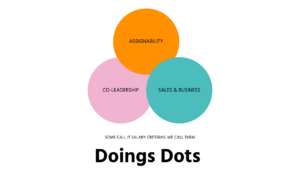Leading with Trust in both Good and Bad Weather
Leading with Trust in Both Good and Bad Weather

Lena Noaksson
Getting employees to enthusiastically follow when everything is going smoothly and the sun is shining isn’t necessarily difficult. However, I believe we often ponder over how challenging it is to lead when circumstances are reversed. When there’s a storm brewing. But is it really so? Have we simply overlooked doing the groundwork – building a trust-based culture?
I dare say that there’s no need for any other keys to successful leadership in a more demanding climate. Not even in more negative change processes such as reorganizations and downsizing processes!
Even in adversity, leadership is about working towards a culture of trust where we create conditions for everyone to be able to, want to, dare to, and understand how we can contribute and engage in what lies ahead.
What is needed is for you as a leader to simply have done your foundational work as a leader before the storms start – you need to have spent at least 20% of your actual time on trust-building activities to build a trust-based culture!
So, honestly, dear leaders, have you done the following to create a trust-based culture:
- Regular conversations with your employees where you manage expectations regarding what you appreciate in their performance and personality, as well as what needs to be developed
- Found out what needs your employees have to contribute in the best way to desired change?
- Transparently informed about everything, all the time?
- Received feedback on your leadership and actually developed your leadership?
- Received input and had dialogues with your employees on how you can become even better together?
- Shared the word and created opportunities for participation – giving everyone the opportunity to contribute with knowledge and opinions (even those who take up the least space)?
- Highlighted good examples and behaviors (which make it easier for others to do the same)?
- Shared (personal) failures and understood the value of turning this into lessons?
- Ensured that you work to maximize each employee’s individual development. So that they are even more employable when they leave your team than when they started?
- Genuinely tried to get to know each person in your team so that you can facilitate co-leadership in the best possible way?
Do you have a score of 10 out of 10? Congratulations – your culture of trust will weather any storm!
Read more here about how we supported a customer in transition.
Do you need support, encouragement, or inspiration in managing a downturn, reorganization, and/or downsizing process? I’m happy to offer you a coffee and discuss further how we can help you build a trust-based culture.
Lena
Share this blog
Payed to live our Values
Payed to live our Values

Emma Forsgren
For me and all of us at Doings, one of the most important things is to practice what we preach – to stop talking and start doing. Of course, this applies to our values and our culture as well – and to have structures that make it easy to do the right thing. Part of this work involves having salary criteria that reflect this. Our values aren’t just a few words but a clearly formulated compass in our LEVA principles:

- Value trust over control
- Value personal engagement over documented knowledge
- Value relationships and collaboration over processes and tools
- Value co-leadership over hierarchical leadership
- Value results over methodology
- Value initiative and action over detailed planning
- Value well-being over financial results
(LEVA is a play on words with Doings’ founders LE (LEna) + EVA (VA), aiming to emphasize well-being, having the energy to live fully, both at work and in life in general. By the way, don’t miss the opportunity to play with words, we believe 😉)
Salary Criteria
These LEVA principles guide us right 11 times out of 10! Except when it came to our salary structure, as I wrote about last week. So, as we finally revamped it, focusing on sustainability, collaboration, and well-being, it was high time to also clarify how we determine salaries. We had been a bit lax about that too, of course. Not about setting it in a sensible way, naturally. But about making it clear, transparent, and as straightforward as possible. (The cobbler’s children, you remember.)
And when it comes to our salary criteria, I’m possibly a little extra proud, as we have a clear expectation regarding culture – to practice what we preach. One-third of the base salary is actually based on just that!
Salary Criteria and Salary Criteria…
We call them our Doings Dots 🙂 The term “salary criteria” even made the cobbler and family yawn. The Doings Dots consist of three parts: Believability, Co-leadership, and Sales and Business.

Our existence, our freedom, and our salary determination are based on our long-term ability to secure our revenue. We do that in several ways. Invoicing is the clearest and most important. But without focusing on the other aspects, we don’t have much to invoice. Our strengths include our commitment, our competence, our curiosity and our constant desire to learn, our relationships, and our LEVA. All of that plays a role when we set and evaluate our base salaries.
Assignability
The higher the “Assignability”, the less financial risk. An important factor in our salary determination is, therefore, the ability and experience to take on various types of assignments. Assignability is about the experience, competence, and consultancy skills to handle a variety of assignments. And of course, to deliver in a Doings way – i.e., with 110% focus on the customer, quality, creativity, and value.
Co-leadership
Our ambition and success lie in working in teams in various ways. Co-leadership means leading oneself but also leading each other, e.g., collaborating and developing competencies and businesses as doers and as an agency. Everyone is a culture cbuilder and engagement spreader – contributing to maintaining and developing Doings’ culture. Making others, including our customers, feel appreciated, helping them develop and feel like heroes, gets us bouncing out of bed in the morning. Additionally, taking responsibility for oneself, being there, supporting each other, and being LEVA and Doings ambassadors in action and behavior. All of this is super important to us and something we constantly strive for.
Sales and Business
Sales are a prerequisite for our business, and money is our freedom. Money isn’t the reason we live, but it’s our oxygen. Our sales strategy and success lie in digging where we stand and spreading our commitment and knowledge, inspiring and daring to challenge. In the Sales Dot, networking and ensuring that we maintain great relationships with customers during assignments and see new opportunities are included. Always wearing the Doings hat and thinking holistically and financially sound. And we always challenge ourselves to find new customers and exciting assignments – for ourselves, for others, and for our agency.
Continuous Development
None of this is hardly the final answer. Everything is an iterative process. We evaluate along the way and adjust together. Now we have a good start and excellent conditions for our continued growth – with clarity, collaboration, development, and what we truly value in focus – win-win-win for both Doings, all doers, and our customers’ development!
/Emma
Share this Blog
A Compensation Model to Reward What We Value Most
A compensation model to reward what we value most

Emma Forsgren
Finally, a new compensation model!
Ever since I joined, Doings, I’ve had a nagging feeling, something that just didn’t fit right. My unease revolved around our compensation model and how it failed to align with our values.
From day one, we’ve fostered an exceptional culture, with clear values, outstanding collaboration and sky-high engagement. Moreover, we’ve been guided by our beacon of LEVA – balancing work and life sustainably over time. We prioritize well-being over financial results (though when necessary, we do focus on financial outcomes).
The issue lies in the fact that, somewhat inadvertently, our compensation model hasn’t mirrored the culture and values we hold dear. Essentially, we’ve had a compensation model that, in theory, incentivizes behaviors diametrically opposed to those we aspire to. Foolish? Absolutely, and somewhat embarrassing too.
The cobbler’s children
We’re masters of change management for goodness’ sake! Daily, we assist our clients in creating the best conditions to activate desired behaviors within their organizations. One of these conditions involves removing organizational obstacles so that culture, structure, and behaviors are synchronized and aligned.
Instead, we, like many reputable consultancy firms out there, have operated under a commission-based model. The more an individual bills, the more they earn. Working an extra project on the weekend (farewell to LEVA) is rewarded on the 25th. Opting not to help a colleague grants more time for personal billing. I must add, though it’s rarely if ever happened, it’s certainly ripe for occurrence. Additionally, this has resulted in a slew of tedious administrative tasks, such as monthly “who did what” reckonings. Such tasks can easily dampen the spirits of even the most enthusiastic team players.
Structuring for growth
So, our compensation model hasn’t bred undesirable behaviors. We owe that to our magical culture and incredibly talented and committed team of doers. But what happens as we expand? The larger we grow, the more vital these structures become, clarifying the culture we espouse and wish to cultivate. What about during challenging times? That’s when structure becomes especially crucial, guiding us in the behaviors we want to foster.
Indeed, we have structures that guide us clearly. We have our fundamental principles that steer us every day. We have an explicit goal to be capped at 75% utilization to allow time for everything else – self-development, packaging our services, team building, balancing life and logistics, and so on. So far, so good! Now, we just need to reflect this in our compensation model too.
Team before self
Something had to be done! Every day, we live by the motto of making things happen, to stop talking and start doing. To test, evaluate, iterate, and get it right. But when it comes to our personal finances, it’s crucial to respect the need for thorough anchoring of any change. It’s about careful consideration, calculation, and discussion beforehand. It’s not just a matter of flipping a switch.
We were on the brink of implementing changes a year ago. Then, a little thing called a pandemic demanded all our attention. But today, I’m bursting with pride to announce that Doings has bid adieu to individual commissions! As of February 1st, we now have a clearer base salary and a team-based commission. It’s tied to our collective performance, not individual billing. Naturally.
Win-win-win
But why have a commission-based salary at all, you might wonder? Isn’t that an outdated tool from the sales world and a time when it was believed that the more you paid, the more engaged employees you’d get? That may be the case sometimes. But for an entrepreneurial, unpredictable consultancy like ours, where costs, success, and revenue are entirely linked to each employee, it’s a good way to create a win-win-win scenario. What benefits the client benefits Doings, which benefits the employee. It’s a means to share both risk and success. It makes our work more enjoyable and strengthens us as a team even further.
The new compensation model makes it even clearer that what we build together is thanks to everyone’s contributions. Therefore, success should benefit everyone. Plus, it makes celebrating success a bit more fun. And we believe in celebrating as often as possible!
Next steps
What obstacles do you face that need clearing to truly let your culture and purpose soar? Do you need help thinking outside the box? Do you want to bounce ideas about change projects in general or incentive structures and compensation models, in particular? Reach out, and let’s grab a coffee 😊
/Emma
Blog two out of two in this series is available to read here – Iit’s about the basis on which we set salaries. We’ve defined a clear expectation of contributing to the culture – living what we preach – and have based one-third of the base salary on just that.


